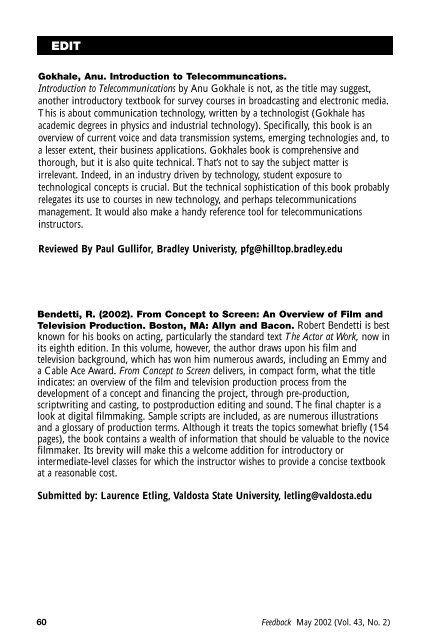Feedback May 2002 (Vol 43 No 2)
Feedback May 2002 (Vol. 43, No. 2) - Broadcast Education ...
Feedback May 2002 (Vol. 43, No. 2) - Broadcast Education ...
- No tags were found...
Create successful ePaper yourself
Turn your PDF publications into a flip-book with our unique Google optimized e-Paper software.
EDITGokhale, Anu. Introduction to Telecommuncations.Introduction to Telecommunications by Anu Gokhale is not, as the title may suggest,another introductory textbook for survey courses in broadcasting and electronic media.This is about communication technology, written by a technologist (Gokhale hasacademic degrees in physics and industrial technology). Specifically, this book is anoverview of current voice and data transmission systems, emerging technologies and, toa lesser extent, their business applications. Gokhales book is comprehensive andthorough, but it is also quite technical. That’s not to say the subject matter isirrelevant. Indeed, in an industry driven by technology, student exposure totechnological concepts is crucial. But the technical sophistication of this book probablyrelegates its use to courses in new technology, and perhaps telecommunicationsmanagement. It would also make a handy reference tool for telecommunicationsinstructors.Reviewed By Paul Gullifor, Bradley Univeristy, pfg@hilltop.bradley.eduBendetti, R. (<strong>2002</strong>). From Concept to Screen: An Overview of Film andTelevision Production. Boston, MA: Allyn and Bacon. Robert Bendetti is bestknown for his books on acting, particularly the standard text The Actor at Work, now inits eighth edition. In this volume, however, the author draws upon his film andtelevision background, which has won him numerous awards, including an Emmy anda Cable Ace Award. From Concept to Screen delivers, in compact form, what the titleindicates: an overview of the film and television production process from thedevelopment of a concept and financing the project, through pre-production,scriptwriting and casting, to postproduction editing and sound. The final chapter is alook at digital filmmaking. Sample scripts are included, as are numerous illustrationsand a glossary of production terms. Although it treats the topics somewhat briefly (154pages), the book contains a wealth of information that should be valuable to the novicefilmmaker. Its brevity will make this a welcome addition for introductory orintermediate-level classes for which the instructor wishes to provide a concise textbookat a reasonable cost.Submitted by: Laurence Etling, Valdosta State University, letling@valdosta.edu60<strong>Feedback</strong> <strong>May</strong> <strong>2002</strong> (<strong>Vol</strong>. <strong>43</strong>, <strong>No</strong>. 2)
















